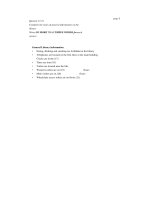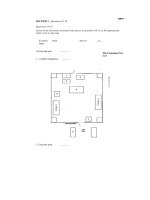Oxford ielts book part 1
Bạn đang xem bản rút gọn của tài liệu. Xem và tải ngay bản đầy đủ của tài liệu tại đây (118.45 KB, 7 trang )
OXFORD UNIVERSITY PRESS AUSTRALIA
Oxford New York
Athens Auckland Bangkok Bombay
Calcutta C. Cape Town Dares Salaam Delhi
Florence Hong Kong Istanbul Karachi
Kuala Lumpur Madras Madrid Melbourne
Mexico City Nairobi Pans Port Moresby
Singapore Taipei Tokyo Toronto
and associated companies in
Berlin Ibadan
OXFORD is a trade mark of Oxford University PrciS
© Wendy Sahanaya, Jeremy Lindeek 1997
First published 1997
This book is copyright Apart from any fair dealing for the purposes
of private study, researeh, criticism or review as permitted under
the Copyright Act, no part may be reproduced, stored in a retrieval
system, or transmuted, in any form or by any means, electronic,
mechanical, photo copying, recording or otherwise without prior
written permission Enquiries to be made to Oxford University
Prew
Copying for educational purposes
Where copies of part or the whole of the book are made under Part
VB of the Copyright Act, the law requires that prescribed
procedures be followed For information, contact the Copyright
Agency Limited
National Library of Australia
Cataloguing in Publication data
Sahanaya, Wendy, 1940-
IELTS preparation and practice listening and speaking
ISBN 019 554095 6
1 English language - Examinations 2 International English
Language Testing System 3 English language - Examinations,
questions, etc 1 Lindeek, Jeremy, 1961- II Title III Title
International English Language Testing System preparation and
practice (Series IELTS preparation and practice)
428
Edited by Eliza Collins
Illustrated byjuli Kent
Text designed by Rob Cowpe Design
Cover design by Rob Cowpe Design
Typeset by Banshee Graphics
Printed through Bookpac Production Services, Singapore
Published by Oxford University Press,
253 Normanby Road, South Melbourne, Australia
Contents
Preface How to use this book
Part 1 The Listening test
About the Listening test X 1
Section 1 7
Section 2 17
Section 3 22
Section 4 25
Listening exercise 1 Names, numbers, places 29
Listening exercise 2 Who's speaking? 31
Listening exercise 3 Study strategies ? 34
Practice Listening tests 36
Parf 2 The Speaking test
What to expect
Phase 2 About yourself
Phase 3 Asking
questions
Phase 4 Wider issues
Practice interviews .
53
54
58
61
64
Transcripts
Appendix Answer
Key
Listening answer
sheet
Speaking test sheet
Acknowledgments
67
93
97
98
99
Preface
How To Use This Book
In this pr.ictice hook you will work your way through a Practice Listening test
from beginning to end You will need to work with the book and the audio
cassette together
When you see the words START YOUR TAPE NOW in the book, you
should start the cassette tape and follow the instructions given in both the
book and on the tape You must start your cassette tape at this point in order
to do the exercises that follow
When you hear and see the words STOP YOUR TAPE you should stop the
cassette tape and work through the explanations and exercises in the book
until you see START YOUR TAPE NOW again
The first part of the book works through a Practice test, section by section,
following the structure of a typical IELTS Listening test The structure of each
section is discussed and the type of questions demonstrated Strategies are sug-
gested for dealing with the various question types as well as for the Listening
test in general The recording for this is on Cassette 1 Side A
START YOUR TAPE NOW
Listen to the instructions that appear on the front of the Listening tt">t
booklet
When you hear the words "now turn to Section one on page two of your ques-
tion booklet"
STOP YOUR TAPE
DO NOT REWIND YOUR TAPE
About The Listening Test
All candidates talking the IELTS Test do the same type of Listening test, but
the version differs according to the test date.
The Listening test takes about 30 minutes, with 10 minutes allocated for
you to transfer your answers from the question booklet to the answer sheet.
The test is in four sections. Each section is more difficult than the one
before. Sections one and two—social situations—are about everyday events,
such as conversations about accommodation or shopping, or short talks giving
practical information for daily living. Sections three and four—-course-related
situations—are about the typical situations students face in their courses of
study, such as discussions with tutors or administrators and short, introductory
course lectures.
The Day of the Test _____________________________________________
On the day of the test you will do the Listening section first. The
examiner will:
• give you an answer sheet for the Listening and the Reading tests
(see
example on page 97)
• read you the general instructions for the whole test
• give you your IELTS Listening test booklet.
The Test Format ________________________________________________
• The test is recorded on a cassette tape.
• You hear the tape once only.
• First, the voice on the cassette tape reads the instructions on the
front of the question booklet.
• Read these instructions as you listen to the tape to become
accustomed
to the speed and accent of the speech.
• You can ask the administrator to adjust the volume, if necessary.
• Do not open your booklet until you are told to do so.
• During the test you are given time to read the questions and to
check back
over your answers. It is very important that you read these
questions
during this time.
• You must answer the questions while you are listening.
• There are between 38 and 42 questions.
• The questions mostly follow the same sequence as the
information con-
tained in the Listening cassette.
• Write your answers to the questions directly into the question
booklet.
• At the end of each section you will be given some time to go
back and
make sure your answers are clear.
• At the end of the test you have 10 minutes to transfer all your
answers to
the answer sheet.
• The tape will tell you when to stop writing.
There is a variety of possible question types. They are as follows:
• multiple choice
• short answers (up to three words)
• sentence completion (no more than three words)
• completing notes, a table or a summary
• labelling a diagram
• matching (e.g. pictures with what you hear).
You will be able to familiarise yourself with all of these kinds of
questions as you work through this book.
Getting the Instructions Right
Note: There are no exercises on the cassette tape for the following questions.
The written instructions in the Listening booklet are always given in italics.
Important aspects of the instructions are also in BOLD ITALIC CAPITALS.
The instructions in the Listening test depend on the type of question. If
you familiarise yourself with the various types of instructions before the test
you will be more likely to follow them properly. Time spent on familiarising
yourself with instructions now, as you work through this book, means that you
will be able to tell at a glance what you have to do in the actual IELTS Test.
You will be less likely to make the more common mistakes.
EXERCISE
The following instructions are typical of those you will find in the IELTS
Listening booklet. Read each of the instructions and questions. Look at what
the candidate did in both the Listening question booklet and on the answer
sheet on page 5. Then say whether the candidate answered the questions
appropriately or not.









